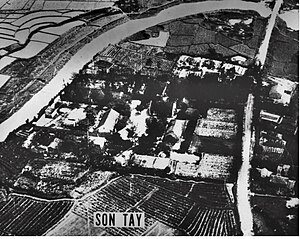
Back Operace Kingpin Czech Operation Kingpin German Operación Costa de Marfil Spanish Boli Kosta operazioa Basque Raid de Son Tay French מבצע חוף השנהב HE Operazione Ivory Coast Italian Operacija Slonokoščena obala Slovenian Vụ tập kích Sơn Tây Vietnamese
| Operation Ivory Coast | |||||||
|---|---|---|---|---|---|---|---|
| Part of the Vietnam War | |||||||
 Sơn Tây prison camp. The walled compound is center left next to the river | |||||||
| |||||||
| Belligerents | |||||||
|
|
| ||||||
| Commanders and leaders | |||||||
| Unknown |
LeRoy J. Manor Arthur D. Simons | ||||||
| Strength | |||||||
| Unknown |
56 Special Forces soldiers[1][2] 92 airmen[3][n 1] 28 aircraft[4] | ||||||
| Casualties and losses | |||||||
|
U.S report: 42 guards killed[5] Vietnamese source: 6 guards killed 7 civilians killed 2 civilians wounded[6] |
None killed 2 wounded 1 helicopter and 1 airplane | ||||||
Location within Vietnam | |||||||
| History of Hanoi |
|---|
 |
| Timeline |
|
|
Operation Ivory Coast was a mission conducted by United States Special Operations Forces and other American military elements to rescue U.S. prisoners of war during the Vietnam War. It was also the first joint military operation in United States history conducted under the direct control of the Chairman of the Joint Chiefs of Staff.[7] The specially selected raiders extensively trained and rehearsed the operation at Eglin Air Force Base, Florida, while planning and intelligence gathering continued from 25 May to 20 November 1970.[8]
On 21 November 1970, a joint United States Air Force and United States Army force commanded by Air Force Brigadier General LeRoy J. Manor and Army Colonel Arthur D. "Bull" Simons landed 56 U.S. Army Special Forces soldiers[1] by helicopter at the Sơn Tây prisoner-of-war camp, which was located 23 miles (37 km) west of Hanoi, North Vietnam. The objective of the operation was the recovery of 61 American prisoners of war thought to be held at the camp. It was found during the raid that the camp contained no prisoners as they had previously been moved to another camp.
Despite the absence of prisoners, the raid's execution was nearly flawless,[9] with only two casualties and two aircraft losses (one of the aircraft losses was due to a planned crash landing during the assault on the prisoner compound).[5][10][11] Criticism of the failure to detect the removal of the POWs prior to the raid, both public and within the administration of President Richard Nixon, led to a major reorganization of the United States intelligence community a year later.[12]
- ^ a b Schemmer (1976), p. 91.
- ^ Thigpen (2001), p. 142
- ^ Gargus (2007), pp. 269–271.
- ^ Gargus (2007). p. 279.
- ^ a b Manor, Brig. Gen. Leroy J. "The Son Tay Raid, November 21, 1970". Air Commando Association. Archived from the original on 9 February 2007. Retrieved 10 February 2009.
- ^ "Kỳ 5: Đêm Sơn Tây không quên lính biệt kích Mỹ đã làm những gì!".
- ^ Gargus (2007), p. 9.
- ^ Schemmer (1976), p. 36, 153.
- ^ Schemmer (1976), p. 153.
- ^ Glines, "The Son Tay Raid"
- ^ Cite error: The named reference
thom121was invoked but never defined (see the help page). - ^ Schemmer (1976), p. 206.
Cite error: There are <ref group=n> tags on this page, but the references will not show without a {{reflist|group=n}} template (see the help page).
© MMXXIII Rich X Search. We shall prevail. All rights reserved. Rich X Search
